Are you looking for a way to strengthen your quads? Resistance band quad exercises are a great way to tone and build muscle in your legs. Not only are they effective, but they’re also convenient and affordable.
Whether you’re a runner looking to prevent knee injuries or just want to strengthen your legs, resistance band quad exercises should be part of your routine.
In this post, we’ll talk about the benefits of resistance band quad exercises, top exercises, and a complete leg workout program that you can do anytime, anywhere.
Let’s get started on building stronger, toned quads!

- Quadriceps Anatomy
- What Is Resistance Band Quad Workout
- How Resistance Bands Work
- 7 Best Quad Exercises With Resistance Band
- 1. Resistance Band Squat
- 2. Resistance Band Leg Extension
- 3. Resistance Band Split Squat
- 4. Resistance Band Leg Press
- 5. Lateral Band Walks
- 6. Resistance Band Jump Squats
- 7. Resistance Band Step-Ups
- Resistance Band Beginner Quad Workout Plan
- Benefits of Resistance Bands for Quad Workouts
- Conclusion
- Know More Resistance Band Exercises
Quadriceps Anatomy
The quads, or quadriceps femoris, located in front of the thigh. They are the largest and strongest muscles in the thigh, and they play an important role in extending the knee and flexing the hip.
The four muscles of the quadriceps are:
- Rectus femoris: the longest muscle in the quadriceps, and it runs along the front of the thigh.
- Vastus lateralis: This muscle is located on the outside of the thigh. It is responsible for giving the thigh its shape.
- Vastus medialis: This muscle is located on the inside of the thigh. It helps to stabilize the knee joint.
- Vastus intermedius: This muscle is located in the middle of the thigh, and it helps to extend the knee.
The four heads merge together, attach onto the patella (knee cap), and then insert via a single (patellar) tendon onto the tibia, just below the knee joint.
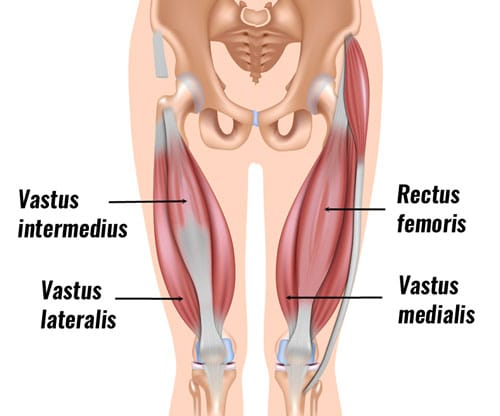
What Is Resistance Band Quad Workout
A resistance band quad workout is an exercise that uses resistance bands to strengthen and tone the quadriceps muscles in the legs.
Resistance bands are a versatile and affordable piece of equipment that can be used to perform a variety of quad exercises.
These exercises are suitable for beginners, intermediate, and advanced lifters, and they can be easily modified to suit your needs.
Some examples of resistance band quad exercises include banded squats, lateral band walks, leg extensions, and split squats.
How Resistance Bands Work
Resistance bands provide unique tension during both the concentric and eccentric phases of each exercise. This means you feel resistance both when you contract the muscle (concentric) and when you lengthen the muscle (eccentric).
- The concentric phase is when you shorten the muscle against resistance, like curling a band up.
- The eccentric phase is when you lengthen the muscle under tension, like lowering the band back down
Want to take your gains to the next level? Discover your daily calorie needs with our free TDEE calculator
7 Best Quad Exercises With Resistance Band
Here are the best 7 exercises for working out your quads with a resistance band. You can do them at home or while traveling. With just an elastic band, you can make a strong, toned leg.
1. Resistance Band Squat
The Resistance Band Squat is a functional exercise that works the quadriceps, hamstrings, glutes, and core. Instead of using free weights or gym machines, it uses a resistance band to challenge the leg muscles.
Resistance bands add additional load and resistance to regular squats, which allows for greater muscle activation.
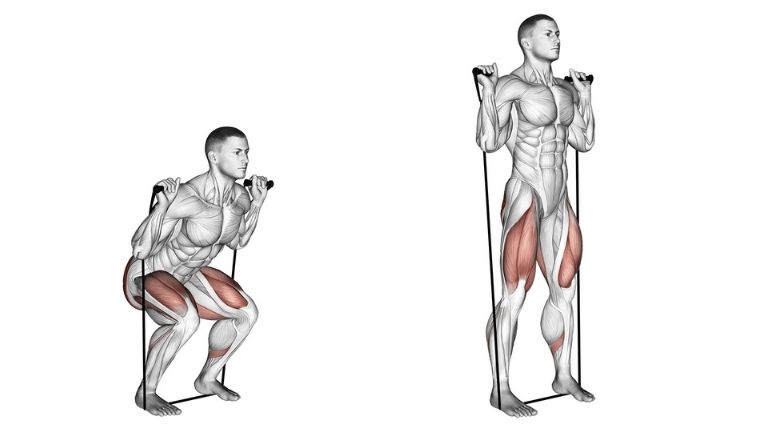
How To Do
- Start with your feet shoulder-width apart, knees bent, and toes pointed forward.
- Place the band under your feet and hold the other end with your hands at shoulder height level.
- Keep your core tight and back straight, and slowly squat down by bending at the hips and knees until a full squat is achieved.
- Pause at the bottom of the squat, then push through your heels to return to the starting position.
- Repeat this motion for the desired number of reps to complete a set.
Tips
- Keep your chest up and shoulders back.
- Ensure your heels remain in contact with the ground throughout the squat. Lifting the heels can place undue stress on the knees.
- Don’t rush. Ensure a steady and controlled descent and ascent.
2. Resistance Band Leg Extension
Resistance band leg extensions are a great way to strengthen and tone your quadriceps muscles. This unilateral approach prevents muscle imbalances. To execute this exercise, you’ll only need a chair and a resistance band.
As an isolation exercise, the tension generated will target the quad muscle and aid in its development, resulting in optimal growth.

How To Do
- Sit on a chair or bench with your back straight.
- Anchor one end of the resistance band under your foot or the leg of the chair, and loop the other end around the ankle of the leg you’re working.
- Start with your knee bent at about 90 degrees.
- Slowly extend your knee and straighten your leg to avoid the pull of the band.
- Make sure you feel the tension in the quadriceps by going until your leg is almost straightened.
- Hold for 2 seconds before slowly returning to the start position with control.
- Complete reps then switch legs. Perform 2-3 sets per leg.
Tips
- Avoid locking out the knee at full extension.
- Increase resistance by reducing the band length.
- Ensure you work both legs equally to avoid muscle imbalances.
3. Resistance Band Split Squat
Resistance band split squats have a unique benefit of overloading the top part of the movement. When you perform the split squat with free weights, the resistance decreases as you move up. However, with resistance bands, the resistance increases as you move up, which makes the exercise more challenging and effective.
Band split squats are one of the best exercises that target the quadriceps muscles. Along with your quads, this exercise also strengthens your hamstrings, glutes, and calves. Because it’s a single-leg exercise, your core has to work harder to keep balance.

How To Do
- Stand with your feet hip-width apart and take a step forward with your right foot.
- Place a resistance band underneath your right foot and hold the ends of the band with your hands to your sides or loop it over your shoulders.
- Lower your body until your right thigh is parallel to the ground and your left knee is almost touching the ground.
- Pause at the bottom of the movement, then push through your right heel to return to the starting position.
- Repeat for the desired number of reps, then switch to the other leg.
Tips
- Make sure to push through the entire foot of the lunging leg, not just the toes or heel.
- Never allow the knee of the front foot to extend beyond the toes to protect the knee joint.
- Make sure you perform an equal number of repetitions on each leg to maintain balanced strength.
4. Resistance Band Leg Press
The resistance band leg press is a powerful exercise that targets the quadriceps. However, it offers the advantage of engaging the entire leg muscles, including the hamstrings, glutes, and calves.
This movement can be done either unilaterally, working one leg at a time, or bilaterally, working both legs at the same time.
The band leg press is a cost-effective way to perform a leg press at home without investing in expensive equipment.
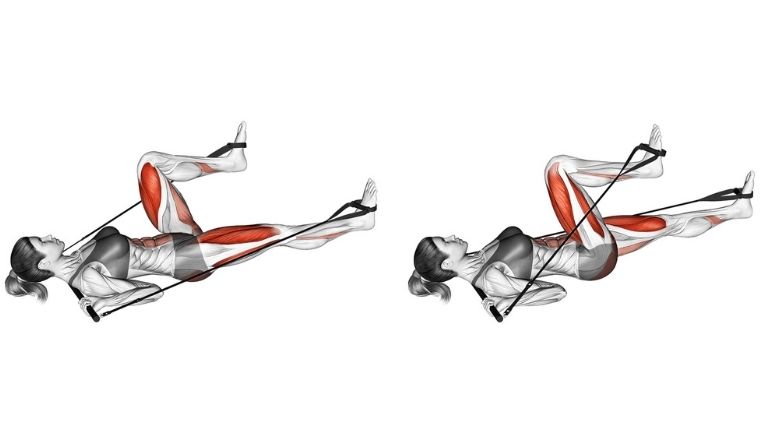
How To Do
- Lie down on the floor or a soft yoga mat.
- Loop the resistance band around the soles of your feet.
- Bend your knees so that your thighs are at a 90-degree angle to your body.
- Hold the ends of the resistance band in your hands and pull them towards your chest, keeping your elbows bent.
- Extend your legs out and push against the band until your legs are straight and the band is taut.
- Now bring your legs back to the original position.
- Perform 10-15 reps.
Tips
- Keep shoulders pressed down and back
- Push through the entire foot, not just balls
- Focus on slow and controlled movements to maximize muscle activation.
5. Lateral Band Walks
Lateral Band Walks, also known as miniband walks, are a lower-body exercise that targets the muscles on the outer thighs and glutes.
Lateral band walks can help reduce hip and back pain by strengthening the muscles that support these areas.
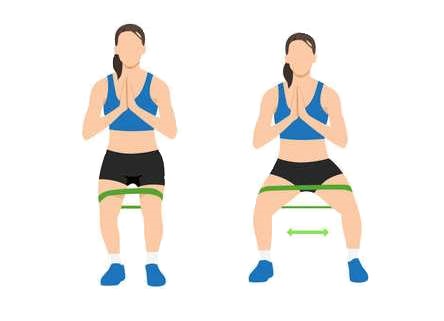
Variations
- Banded monster walks: To do banded monster walks, simply loop the resistance band around your ankles instead of your thighs.
- Banded side shuffles: To do banded side shuffles, simply shuffle sideways instead of walking.
How To Do
- Start by placing a looped resistance band around your legs, just above your ankles.
- Stand with your feet hip-width apart and your knees slightly bent.
- Take a step to the side with one foot, stretching the band, and then bring the other foot in to return to the shoulder-width stance. This completes one step.
- Continue this pattern for a set number of steps in one direction, then switch to move in the opposite direction.
Tips
- For increased difficulty, place it just above the ankles; for decreased difficulty, place it above the knees.
- Keep tension on the band at all times.
- Maintain an upright posture, do not lean.
6. Resistance Band Jump Squats
Resistance Band Jump Squats are a high-intensity exercise that can help improve cardiovascular fitness and burn calories. It combines the explosive nature of jump squats with the added tension of a resistance band.
It is a great way to increase power and explosiveness in the legs, which can help improve athletic performance. Along with your quads, this exercise strengthens your hamstrings, glutes, and calves.
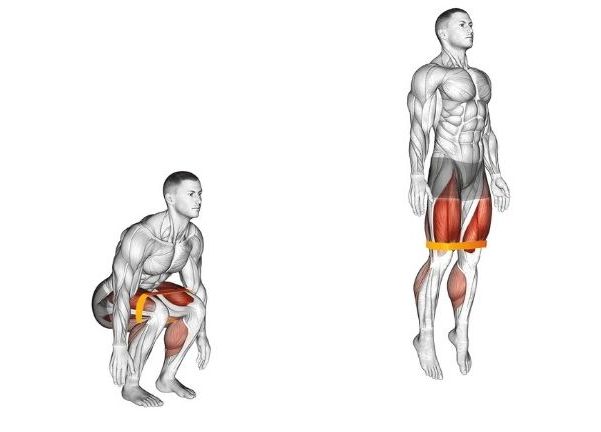
How To Do
- Stand with your feet shoulder-width apart and place a resistance band around your thighs, just above your knees.
- Lower your body into a squat position. Keep your core engaged and back straight.
- Explosively push through the heels and jump upward, extending the legs while maintaining tension on the band.
- Land softly on the balls of your feet and immediately lower your body back into a squat position.
- Repeat for the desired number of reps.
Tips
- Always aim for a gentle landing to minimize the strain on your joints.
- To increase difficulty, use a thicker resistance band or aim for higher jumps.
7. Resistance Band Step-Ups
Resistance band step-ups are a great way to improve lower body strength and build quad muscle in the legs.
The stepping action can help improve hip, knee, and ankle mobility.
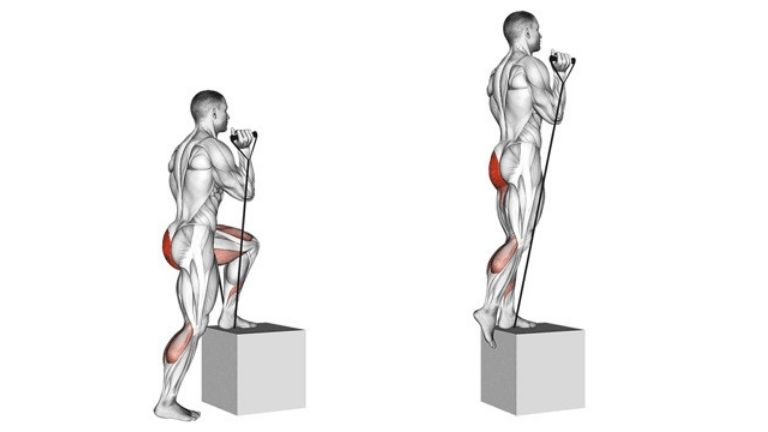
How To Do
- Stand in front of a box or stable platform. The resistance band should be looped under one foot and the other end should be close to your chest or shoulders.
- Begin with feet hip-width apart, chest lifted, and core engaged.
- Step one foot onto the platform and press through the heel, lifting your body upwards.
- Complete the motion by standing fully atop the platform.
- Control your descent as you step backward to the ground, maintaining balance.
- Perform desired reps on one leg, then switch to the other.
Tips
- Start with a lower box or bench and work your way up.
- Control step down, don’t just drop.
- Ensure the box or platform is stable.
Resistance Band Beginner Quad Workout Plan
For a beginner resistance band quad workout, try the following routine:
| Exercise | Sets | Reps | Rest |
|---|---|---|---|
| Band Squat | 3-4 | 10-12 | 90s |
| Band Leg Extension | 3-4 | 12-15 | 90s |
| Band Leg Press | 3 | 12-15 | 90s |
| Band Box Lunge | 3 | 10-12 | 90s |
Benefits of Resistance Bands for Quad Workouts
- Versatility: Suitable for various exercises targeting different parts of the quads.
- Portability: Lightweight and easy to carry, making on-the-go workouts feasible.
- Progressive Resistance: Bands come at varying resistance levels, allowing for progressive strength training.
- Joint Safety: Offers low-impact exercises, reducing strain on the knees and joints.
- Stability: Engages stabilizing muscles, enhancing balance and coordination.
- Cost-Effective: A budget-friendly alternative to weight machines and dumbbells.
- Full Range of Motion: Allows for natural and full movement arcs during exercises.
- Adaptable: Can be used in conjunction with other equipment for hybrid workouts.
- Functional Strength: Mimics real-world movements, aiding in daily activities.
- Continuous Tension: Maintains tension throughout exercises, ensuring consistent muscle engagement.
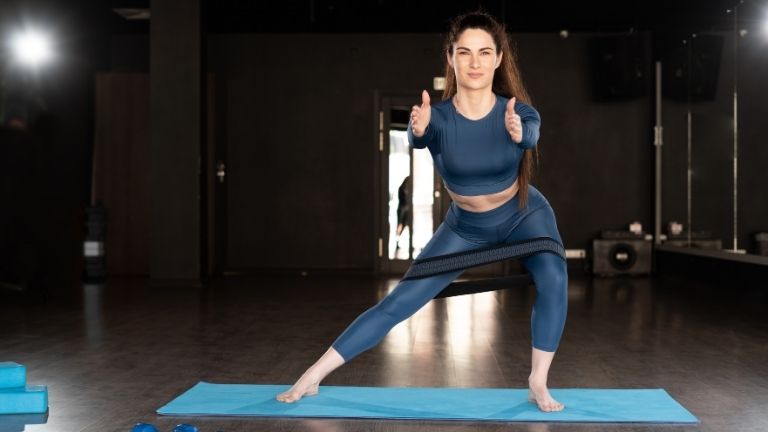
Conclusion
Resistance bands are a great way to strengthen and tone all the muscles of your leg muscles. They’re a versatile and affordable way to work out your quads at home or at the gym.
With resistance bands, you can do many different arm exercises that work all the major muscle groups in different ways.
If you do resistance band workouts regularly, your lower body muscles will get stronger and have more definition.
Know More Resistance Band Exercises
- Best Resistance Band Chest Exercises
- Resistance Band Back Workouts
- Best Resistance Band Shoulder Exercises
- Resistance Band Trap Exercises
- Best Resistance Band Tricep Exercises
References
- Gooyers CE, Beach TAC, Frost DM, Callaghan JP. The influence of resistance bands on frontal plane knee mechanics during body-weight squat and vertical jump movements. Sports Biomechanics. 2012;11(3):391-401. doi:10.1080/14763141.2012.654503
- Nyberg A, Hedlund M, Kolberg A, Alm L, Lindström B, Wadell K. The accuracy of using elastic resistance bands to evaluate muscular strength. European Journal of Physiotherapy. 2014;16(2):104-112. doi:10.3109/21679169.2014.889746

Manish brings over 10 years of hands-on experience in weight lifting and fat loss to fitness coaching. He specializes in gym-based training and has a lot of knowledge about exercise, lifting technique, biomechanics, and more.
Through “Fit Life Regime,” he generously shares the insights he’s gained over a decade in the field. His goal is to equip others with the knowledge to start their own fitness journey.
